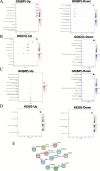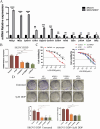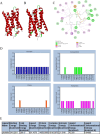Comprehensive analysis of hub genes associated with cisplatin-resistance in ovarian cancer and screening of therapeutic drugs through bioinformatics and experimental validation
- PMID: 38987777
- PMCID: PMC11234624
- DOI: 10.1186/s13048-024-01461-w
Comprehensive analysis of hub genes associated with cisplatin-resistance in ovarian cancer and screening of therapeutic drugs through bioinformatics and experimental validation
Abstract
Background: To identify key genes associated with cisplatin resistance in ovarian cancer, a comprehensive analysis was conducted on three datasets from the GEO database and through experimental validation.
Methods: Gene expression profiles were retrieved from the GEO database. DEGs were identified by comparing gene expression profiles between cisplatin-sensitive and resistant ovarian cancer cell lines. The identified genes were further subjected to GO, KEGG, and PPI network analysis. Potential inhibitors of key genes were identified through methods such as LibDock nuclear molecular docking. In vitro assays and RT-qPCR were performed to assess the expression levels of key genes in ovarian cancer cell lines. The sensitivity of cells to chemotherapy and proliferation of key gene knockout cells were evaluated through CCK8 and Clonogenic assays.
Results: Results showed that 12 genes influenced the chemosensitivity of the ovarian cancer cell line SKOV3, and 9 genes were associated with the prognosis and survival outcomes of ovarian cancer patients. RT-qPCR results revealed NDRG1, CYBRD1, MT2A, CNIH3, DPYSL3, and CARMIL1 were upregulated, whereas ERBB4, ANK3, B2M, LRRTM4, EYA4, and SLIT2 were downregulated in cisplatin-resistant cell lines. NDRG1, CYBRD1, and DPYSL3 knock-down significantly inhibited the proliferation of cisplatin-resistant cell line SKOV3. Finally, photofrin, a small-molecule compound targeting CYBRD1, was identified.
Conclusion: This study reveals changes in the expression level of some genes associated with cisplatin-resistant ovarian cancer. In addition, a new small molecule compound was identified for the treatment of cisplatin-resistant ovarian cancer.
Keywords: Bioinformatics analysis; Cisplatin resistance; Molecular docking; Ovarian cancer; miRNA-mRNA pairs.
© 2024. The Author(s).
Conflict of interest statement
The authors have no relevant financial or non-financial interests to disclose.
Figures







Similar articles
-
Bioinformatics analysis of mRNA and miRNA microarray to identify the key miRNA-mRNA pairs in cisplatin-resistant ovarian cancer.BMC Cancer. 2021 Apr 23;21(1):452. doi: 10.1186/s12885-021-08166-z. BMC Cancer. 2021. PMID: 33892654 Free PMC article.
-
Cross‑validation of genes potentially associated with neoadjuvant chemotherapy and platinum‑based chemoresistance in epithelial ovarian carcinoma.Oncol Rep. 2020 Sep;44(3):909-926. doi: 10.3892/or.2020.7668. Epub 2020 Jul 2. Oncol Rep. 2020. PMID: 32705213 Free PMC article.
-
Screening of potential targets and small-molecule drugs related to lipid metabolism in ovarian cancer based on bioinformatics.Biochem Biophys Res Commun. 2024 Nov 12;733:150673. doi: 10.1016/j.bbrc.2024.150673. Epub 2024 Sep 11. Biochem Biophys Res Commun. 2024. PMID: 39293329
-
Integrated bioinformatics analysis for the screening of hub genes and therapeutic drugs in ovarian cancer.J Ovarian Res. 2020 Jan 27;13(1):10. doi: 10.1186/s13048-020-0613-2. J Ovarian Res. 2020. PMID: 31987036 Free PMC article.
-
Identification and validation of genes associated with prognosis of cisplatin-resistant ovarian cancer.BMC Cancer. 2024 Aug 5;24(1):508. doi: 10.1186/s12885-024-12264-z. BMC Cancer. 2024. PMID: 39103807 Free PMC article.
Cited by
-
Prognostic Value of Ubiquitination-Related Genes in Ovarian Cancer and Their Correlation With Tumor Immunity.Hum Mutat. 2025 Jul 15;2025:8369299. doi: 10.1155/humu/8369299. eCollection 2025. Hum Mutat. 2025. PMID: 40697329 Free PMC article.
-
Unveiling ammonia-induced cell death: a new frontier in clear cell renal cell carcinoma prognosis.Front Immunol. 2025 Jul 31;16:1636977. doi: 10.3389/fimmu.2025.1636977. eCollection 2025. Front Immunol. 2025. PMID: 40821775 Free PMC article.
-
Identification and validation of matrix metalloproteinase hub genes as potential biomarkers for Skin Cutaneous Melanoma.Front Oncol. 2024 Oct 18;14:1471267. doi: 10.3389/fonc.2024.1471267. eCollection 2024. Front Oncol. 2024. PMID: 39493455 Free PMC article.
References
-
- Moller P, Seppala T, Bernstein I, Holinski-Feder E, Sala P, Evans DG, et al. Cancer incidence and survival in Lynch syndrome patients receiving colonoscopic and gynaecological surveillance: first report from the prospective Lynch syndrome database. Gut. 2017;66(3):464–72. doi: 10.1136/gutjnl-2015-309675. - DOI - PMC - PubMed
MeSH terms
Substances
Grants and funding
LinkOut - more resources
Full Text Sources
Medical
Research Materials
Miscellaneous

